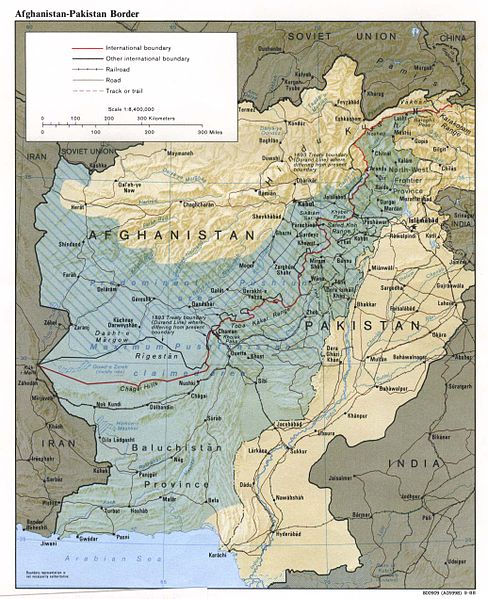
The Durand Line winds through some of the world’s most remote and mountainous terrain. More than that the 1,510-mile border between Afghanistan and Pakistan separates the two rival countries and often serves as a flashpoint. The notoriously porous border has also encouraged the Taliban and other extremists’ groups to seek sanctuary or resources in Pakistan. Pakistani terrorists’ groups and smugglers of all descriptions have used the border in similar ways.
America’s Shadow War With Iran
“With the impending drawdown of the United States from the region Pakistan will push to maintain the Durand Border at all costs,” says Salman Siddiqui an academic in London who worked for years in Pakistan.
“This becomes the red-line for Pakistan though it will likely use proxies to maintain influence across it.”
Afghanistan has long disputed the border with Pakistan. Afghanistan even casting the sole vote against Pakistan’s membership in the United Nations over the issue. During the Cold War, Pakistan dutifully joined two U.S. supported defense regional defense assurances similar to NATO (CENTO and SEATO) in part over concerns over Afghanistan’s territorial claims.
“They are Muslim countries and have no religious or even sectarian clashes, because both are pre-dominantly Sunnis,” says noted Afghanistan analyst Daud Khattak, “Pakistan and Afghanistan would happily live as neighbours if this issue is settled on paper.“
However, the border between the two continues to be a sticking point. While Pakistan inherited its borders from the British colonial empire — Afghanistan’s borders have long varied. At one point in the 1820s, Afghanistan was reduced to little more than Kabul, Kandahar, Ghazni, Kabul and Peshawar (see this map).
For Pashtuns, the Durand Line (so named for the British negotiator who struck the accord in 1893 with the Emir of Afghanistan) fails to reflect cultural and linguistic similarities, and they have opposed efforts to mine and fence the border.
Russia On A Mission To Keep Iran’s Mullahs In Power
“The Durand Line is the unfinished agenda of the colonial-era in this region,” said Daud Khattak, an expert on Pashtun affairs.
Some Pashtun nationalists fondly recall the days Peshawar was ruled from Afghanistan, and some go even farther calling for an expanded Afghanistan that would include Baluchistan and with it access to the sea. Others propose a third country, an independent “Pashtunistan” between a rump Afghan-state and Pakistan. Both dreams are just that given Pakistan’s nuclear arsenal, though stratigists in India would be pleased with that outcome.
Access to the sea for Afghanistan more broadly defined remains a vital issue, such that the Trump administration did not target the Iranian Chabahar port project as part of new sanctions imposed by the United States government on Iran. The project is receiving significant funding from Pakistan’s archrival India and is designed to give Afghanistan trade a non-Pakistani port for maritime access. The project is a potential game-changer for the region’s geopolitics.
During the 19th century, Britain’s colonial empire rapidly expanded toward Central Asia as it sought to ward off encroachment by Russia. This led to an ill-fated British occupation of Afghanistan during the first Anglo-Afghan War of 1839-1842. During the retreat from Jalalabad in 1842, some 16,500 soldiers and civilians were killed, captured, or went missing. Only a few hundred Indian sepoys and a single European survived retreat. In 2013, The Economist called the retreat “the worst British military disaster until the fall of Singapore exactly a century later.”
Only thirteen years before Durand’s agreement another British force had been badly defeated at the Battle of Maiwand near Kabul, which coming so soon after the British military humiliations in the Zulu War of 1879 was a low point for the British imperial ambition.
In truth the region and in particular the Khyber Pass which dominates the border has been considered strategic for centuries. In ancient times, Alexander the Great used the route to march into India. Today it is still considered a strategic choke point.
An important but, forgotten part of NATO’s war in Afghanistan was fought by Pakistan to protect trucks laden with NATO supplies headed across the Durand Line. During the height of the NATO involvement in Afghanistan, some 70 per cent of ISAF supplies travel through the Khyber Pass from Pakistan to Afghanistan. Some convoys were ambushed or torched by terrorists to disrupt NATO’s supply lines.
With an impending U.S. withdrawal from the region, and Pakistan hoping to complete the border within the next two years, the border could again become a serious flashpoint. The last decades have seen some of the most violent border skirmishes between the two countries since the early 1950s.
Pakistan (or Trump’s) plan to build a disputed border wall would not have surprised the British colonial elites of a century ago.
“Frontiers are the chief anxiety of nearly every foreign office in the civilised world, said British Indian Viceroy Lord Curzon of Kedleston at a 1907 conference at Oxford University, “They are moreover the razor’s edge on which hang suspended the modern issues of war or peace, of life or death to nations.”

